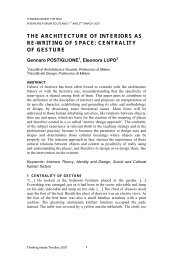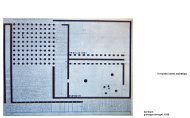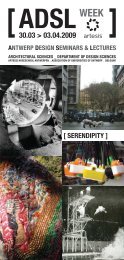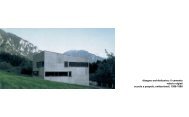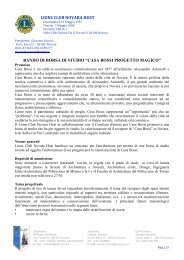the atlantic wall: bunker and/as modern architecture - lablog
the atlantic wall: bunker and/as modern architecture - lablog
the atlantic wall: bunker and/as modern architecture - lablog
Create successful ePaper yourself
Turn your PDF publications into a flip-book with our unique Google optimized e-Paper software.
fig. 4: Picture of a <strong>bunker</strong> along <strong>the</strong> Atlantik Wall (Propag<strong>and</strong>a photo © Bundesarchiv Koblenz/D).<br />
Therefore, comparing, for example, <strong>the</strong> towers erected by Germans on <strong>the</strong> Channel Isl<strong>and</strong>s <strong>and</strong> <strong>the</strong> profile of<br />
Wright's Guggenheim Museum in New York (1956), we again discover a disturbing formal parallel: a narrow<br />
vertical crevice <strong>as</strong> <strong>the</strong> characterising architectural motif. But <strong>the</strong>re are also o<strong>the</strong>r similarities to be noticed, for<br />
instance, with a large part of <strong>architecture</strong> built before <strong>the</strong> war, from Mendelsohn's Einstein Tower in Potsdam<br />
(1919-20) to Steiner's Goe<strong>the</strong>naum in Donarch (1924-28), or some typologies of great civilian <strong>architecture</strong>,<br />
like American barns celebrated by Le Corbusier himself (Le Corbusier, 1923), author, among o<strong>the</strong>rs, of <strong>the</strong><br />
Mon<strong>as</strong>tery Sante-Marie de La Tourette. Built in 1959, its nor<strong>the</strong>rn façade presents itself like a profile of a<br />
<strong>bunker</strong>. The lateral <strong>wall</strong>s of <strong>the</strong> chapel, with three openings that let light into <strong>the</strong> underground room (called<br />
by Le Corbusier "cannon lights"!), according to Colin Rowe, create a series of whirling forces, just <strong>as</strong> it is <strong>the</strong><br />
c<strong>as</strong>e with <strong>bunker</strong>s' forms/forces. Bruno Zevi speaks in his history of <strong>architecture</strong> about <strong>the</strong> ab<strong>and</strong>onment of<br />
cl<strong>as</strong>sicism, about <strong>the</strong> end of <strong>the</strong> cl<strong>as</strong>sic <strong>and</strong> rationalist era (Zevi, 1975). Therefore <strong>bunker</strong>s can be seen <strong>as</strong> a<br />
link between pre-war <strong>and</strong> post-war <strong>architecture</strong>: a sort of bridge connecting different periods of Modern<br />
Movement.<br />
This enables <strong>the</strong> introduction of ano<strong>the</strong>r <strong>as</strong>pect that <strong>the</strong> Atlantic Wall buildings have in common with <strong>modern</strong><br />
<strong>architecture</strong>: <strong>the</strong> use of reinforced concrete implies indeed not only an aes<strong>the</strong>tic, but also <strong>the</strong> industrial<br />
process of a construction system.<br />
CEMENT, MONOLITHIC ARCHITECTURE AND INDUSTRIAL PRODUCTION<br />
Reinforced concrete is <strong>the</strong> material choose by <strong>modern</strong>ist <strong>architecture</strong>. A liquid substance that, when poured<br />
into a mould, can serve to model any type of <strong>architecture</strong> <strong>and</strong>, once consolidated, is left to be viewed.<br />
Already from <strong>the</strong> second half of <strong>the</strong> 19 th century, <strong>the</strong> new material seemed capable of giving a clean<br />
expression to <strong>the</strong> functional programme, of following <strong>and</strong> adapting itself to <strong>the</strong> dem<strong>and</strong>s of use, of being a<br />
valid alternative to iron, thought <strong>as</strong> <strong>the</strong> construction material for excellence («R<strong>as</strong>segna», 42/1992). More<br />
than o<strong>the</strong>r materials concrete possessed all characteristics necessary to transform <strong>the</strong> construction process<br />
from h<strong>and</strong>craft into industry. Le Corbusier, with his search of <strong>the</strong> industrialisation of domestic <strong>architecture</strong>,<br />
appeared <strong>as</strong> a pioneer: from 1915, with <strong>the</strong> project of Maison Dom-Ino, to <strong>the</strong> realisation of Unité<br />
d'Habitation in Marseille (1947-52). Even Auguste Perret, like many of his contemporaries closely related to<br />
<strong>the</strong> cl<strong>as</strong>sical architectural tradition, at <strong>the</strong> beginning of <strong>the</strong> 20 th century conducted certain architectural<br />
experiments using reinforced concrete, but his research – like <strong>the</strong> ones of many o<strong>the</strong>rs - did not entail<br />
structural issues <strong>as</strong> much <strong>as</strong> linguistic ones: he w<strong>as</strong> only looking for a canon for <strong>the</strong> new material<br />
(Singelenberg, 1972).<br />
DOCOMOMOiberico-CADIZ2007_paper postiglione p 4




